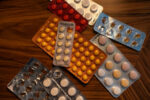Facts on Heart Attacks
- A heart attack is caused by a blood clot that completely or partially closes a coronary artery that supplies the heart muscle with blood
- Sudden chest pain typically occurs with radiation to the arm, often without notice
- The patient may be very poor with turmoil, shortness of breath and feeling of suffocation. The person may also be sweating or distant and possibly unconscious
- The most important thing is to quickly get medical help. Call 112 and call ambulance
Background
- A heart attack is caused by clogging, usually a blood clot that is formed inside a pulmonary artery (artery) that brings blood to parts of the heart muscle
- Clogging causes this part of the heart muscle to lose its blood supply. The consequence of this depends on how much of the heart muscle is deprived of blood supply. In the majority of cases you get acute chest pain
- The most serious, acute complication of a heart attack is that a heart rhythm disorder occurs – ventricular fibrillation – leading to cardiac arrest
- If you suspect that a person has a heart attack, calm them down. Ask him or her to sit down. Make sure to call an ambulance and that the person arrives at the hospital as soon as possible
Typical symptoms and signs
- Chest pain, constricting, can radiate into the jaw and into the arms
- Klam and cold sweeteners
- Nausea and vomiting
- Possible respiratory distress
- Possible dizziness and fainting tendency
- Possible blue about the lips
First aid
- Get that person to sit down
- It’s best that you get the person to lean backwards and rest your back against a wall or chair so that your head and shoulders have support and your knees are bent
- Call emergency medical assistance
- If you live far away from a hospital or a doctor, sometimes it may be faster to get the sick into a car and drive to the nearest hospital
- It may be necessary to use helicopter transport
- If you have a heart attack, never drive yourself
- Take a tablet with salicylate
- For example, children’s magnet or a coding magnet. Fabric it to speed up the recording
- If the patient has nitroglycerin, it should be taken
- Begin heart lung guidance
- If the sick person is unconscious, the emergency medical center you may call (112) asks you to start with heart lung surgery
- Even if you do not have training in it, you can explain how to do it
- Continue with this until the help comes







